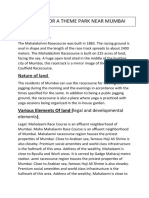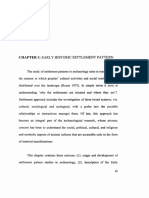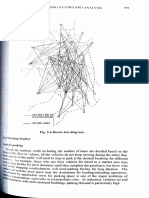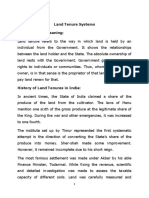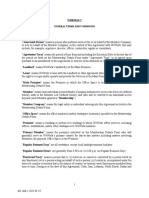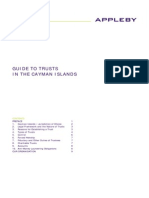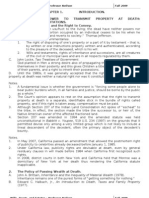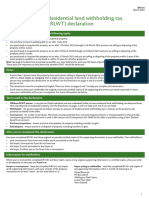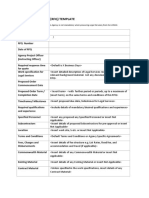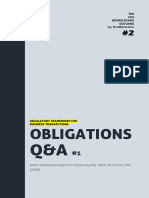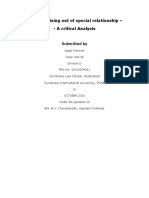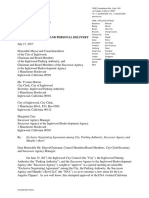Easement Act Architecture Module 4 Professional Practice 2 15arc8.4
Easement Act Architecture Module 4 Professional Practice 2 15arc8.4
Uploaded by
Noothan MCopyright:
Available Formats
Easement Act Architecture Module 4 Professional Practice 2 15arc8.4
Easement Act Architecture Module 4 Professional Practice 2 15arc8.4
Uploaded by
Noothan MOriginal Title
Copyright
Available Formats
Share this document
Did you find this document useful?
Is this content inappropriate?
Copyright:
Available Formats
Easement Act Architecture Module 4 Professional Practice 2 15arc8.4
Easement Act Architecture Module 4 Professional Practice 2 15arc8.4
Uploaded by
Noothan MCopyright:
Available Formats
1.
Land tenure:
Land tenure refers to the way in which land is held by an individual from the Government. It shows
the relationships between the land holder and the State. The absolute ownership of land rests with
the Government. Government gives proprietary rights to individuals or communities. Thus, whom we
call a land owner, is in that sense is the proprietor of that land and he has to pay land renew for that.
History of Land Tenures in India:
In ancient times, the State of India claimed a share of the produce of the land from the cultivator. The
laws of Manu mention one sixth of the gross produce at the legitimate share of the King. During the
war and other emergencies, it was increased to one fourth.
The most famous settlement was made under Akbar by his able Finance Minister, Todarmal. While
fixing the revenue, scientific and detailed investigation was made to assess the taxable capacity of
different soils. Land was carefully measured and divided into four classes representing different grades
of fertility. The Government’s share was fixed as one-third of the gross produce.
In the declining days of Mughal Empire, the control over the revenue officials became weak. The flow
of income started declining. So, the system called ‘revenue farming’ was introduced in Bengal in the
reign of Farukhsiyer (1713-19). Under this system, the revenue farmer paid the Government nine-
tenth of the whole collection and kept the rest as his collection charges. However, in the later period,
the right of collecting land revenue for a pargana or a district was sold by public auction to the highest
bidders. Due to this, the exploitation of the cultivators started. The revenue farmers became more
dominant. This revenue farming system which started during the Mughal rule in Bengal was soon
extended to other parts of the country.
Land Tenures under British Rule: Under British Rule, there were three main types of land tenure
systems in India.
They were Zamindars, Mahalwari and Rayatwari.
• Zamindari: This system was introduced by Lord Cornwallis in Bengal in 1973. Under this
system, the lands of a village or few villages was held by one person or few joint owners who
were responsible for payment of land revenue to the Government. There used to be number
of intermediaries between the Zamindars and the actual tillers of the soil. The system took
were various forms such as Zamindari, Jagirdari, Inamdari, etc. In many cases revenue
collectors were raised to the status of land owners. This system was introduced in many parts
of the country. In this system, tillers of the soil were exploited by way of exorbitant rents.
There were no incentives for them to improve the land or to use better cultivation practices.
There were many other social evils of the system. It is said that the British introduced
Zamindari system to achieve two objectives. First, it helped in regular collection of land
revenue from a few persons i.e. Zamindars. Secondly, it created a class of people who would
remain loyal to the British ruler in the country.
• Mahalwari: Under this system, the village lands were held jointly by the village communities,
the members of which were jointly and severally responsible for the payment of land revenue.
Land revenue was fixed for the whole village and the village headman (Lumberdar) collected
it for which he received ‘Panchatra’ i.e. 5 per cent as commission.
• Rayatwari: It was introduced by Sir Thomas Munro first in Madras state and then in Bombay
State. In this system, there was a direct relationship between Government and the tenant or
Rayat i.e. individual land holder. Every registered holder was recognised as its proprietor and
1
he could sell or transfer the land. He was assured of permanent tenure as long as he paid the
Page
PP-II, Module 4, part 2. (Notes)_Sanjyot
land revenue. The land holder was also allowed to sublet his land. It was a better system as
compared to Zamindari or Mahalwari and similar other forms of tenure.
There was lot of intermixing of characteristics of these systems. It is said that these three systems
gravitated towards the tendencies of the Zamindari system. The Mahalwari system in states like
Madhya Pradesh and Uttar Pradesh subletting and rock renting became common. It became common
even in the Rayatwari areas. There was no proper revenue record. This was the situation which
prevailed at the time of independence.
Post-independence Period:
Our leaders had thought about the need for land reforms even prior to independence. For instance,
the Agrarian Reforms Committee under Shri J. C. Kumarappa had given the guidelines for the
formulation of land reform policies in the independent India. The committee recommended that
i. all intermediary interest should be abolished and land should belong to the tiller;
ii. leasing of land should be prohibited except in case of widows, minors and other disabled
persons.
iii. All the tenants who had been cultivating land for a period of 6 years should be granted
occupancy rights
iv. The tenants should have the right to purchase the holdings at reasonable price to be
determined by the land tribunal;
v. The agrarian economy should provide an opportunity for the development of the farmers.
Abolition of Zaminari and Intermediaries Acts:
India’s First Five-year plan has clearly mentioned the land policy and the specific land reform measures
to be undertaken. Most of the states passed the legislations for abolition of zamindari and similar
exploitative land tenure systems. The first act in this respect was passed in Madras in 1948. The other
states followed it. Now land tenure systems like Zamindari, Mahalwari, Jagir, Inam, etc. are abolished
in all the states in the country.
It has been said that in implementation of land reforms, this first and the important step of abolition
of zaminari was completed peacefully.
As a result of abolition of Zaminari and intermediaries, about 26 lakh intermediaries and 20 lakh
tenants got proprietary rights of lands i.e. they became the land owners. This has resulted in improving
their economic and social conditions. The land revenue income of the states also increased.
Tenancy reforms:
Tenancy refers to the relation between the land holder (owner) and the actual tiller of the soil. Many
of the land owners did not cultivate their lands personally but gave it to some tiller and took rent for
that. They were absentee landlords. The tenancy prevailed in all forms of land tenure systems
including Rayatwari system. The main reason was the increase in the population of landless labourers.
In 1951, of the total family’s dependent on agriculture, as many as 23.6 per cent families belonged to
the tenant class. The National Sample Survey (8th round) indicated that the lands leased out varied
from 11 per cent to 26 per cent of the total, in different states. The tenants were exploited by the land
owners by way of heavy rents (50 per cent or even 2/3rd of the produce). There was no protection of
tenure (evictions on minor pretexts). Thus, there were no incentives for tenants to make land
improvements or to increase production. This necessitated enacting the legislation for tenancy
2
reforms. Tenancy Acts were passed in most of the States, they provided for
Page
i. regulation of rents
PP-II, Module 4, part 2. (Notes)_Sanjyot
ii. security of tenure, and
iii. conferment of ownership on tenants.
Bombay State promptly enacted the legislation as early as in 1950. As regards the regulation of rents,
different states fixed different rates. For instance, in Bombay (Maharashtra), Gujarat and Rajasthan,
one-sixth of the grass produce has been fixed as the maximum rent; while in Punjab rent fixed is one-
third of the produce.
It was found that there were large scale evictions of tenants on the plea of resumption for personal
cultivation.
As reported in the draft fourth five-year plan, as a result of tenancy legislations in India, 3 million
tenants or share croppers became the land owners. Uttar Pradesh was in the forefront in this respect.
The next state in order is Maharashtra where 13.56 lakh tenants got the ownership rights of about 32
lakh hectares of land by September, 1992.
Protection of tenants and regulation of rent is the first step in the tenancy reforms. The ultimate object
of the reform is "land to the tiller". The Tenancy Acts have been moved in that direction.
It could be said that the land reform measures adopted by the States soon after independence,
provided a sound basis for agricultural developments that took place in the country in the later period.
3
Page
PP-II, Module 4, part 2. (Notes)_Sanjyot
2. Land Holdings
Types of Landholdings in India
Operational Holding: All land which is used wholly or partly for agricultural production and is operated
as one technical unit by one person alone or with others without regard to the title, legal form, size or
location.
Technical unit: A technical unit has been defined as that unit which is under the same management
and has the same means of production such as labour force, machinery and animals etc.
Operational holder:
An Operational holder is the person who has the responsibility for the operation of the agricultural
holding and who exercises the technical initiative and is responsible for its operation. He may have full
economic responsibility or may share it with others. The Operational holder may be Individual/Joint/
Institutional.
a. Individual Operational Holder: If the holding is being’ operated-either by one person alone or
by group of persons who are the members of the same household, it will be considered as an
individual holding.
b. Joint Operational Holder: If two or more persons belonging to different households share
jointly as partners in the economic and technical responsibility for the operation of an
agricultural holding, such holding would be considered as Joint.
c. Institutional Operational Holder: Holdings such as government farms, sugarcane factories
and cooperative farms lands managed by trust would be treated as institutional.
Complete/Part-Holding:
A holding is said to be complete holding if the entire, operated area of that holding is located in one
village. If the operated area is spread over more than one village, it would be considered as part-
holding. Tehsil would be taken as the outer limit for consolidation of part holdings.
Resident and Non-resident operational holder:
All the cultivators residing in a particular village cultivating some land are resident cultivators of that
village irrespective of the fact whether they are cultivating land within that village or outside. A
resident cultivator may have,
(i) entire area of the holding located in the village of his residence;
(ii) partly within the village of residence and partly outside; and
(iii) entirely outside the village of residence.
An Operational holder operating some area outside the tehsil in which his village of residence falls will
not be treated as a resident cultivator of the village of his residence for Agricultural Census purposes.
He will be treated as a resident cultivator of the village outside the tehsil where the area falls.
If the area in a particular village is operated by a cultivator who resides outside that village, he is a
non-resident operational holder for that area. However, if this operational holder is resident of a
village lying outside the tehsil in which the area is located, he will be treated as a resident operational
holder of the village where the area is located.
Agricultural Production: Agricultural production includes growing of field crops, fruits, grapes, seeds,
tree nurseries (except those of forest. trees), vegetables and flowers, production of coffee, tea, cocoa,
rubber, jute, oilseeds, fodder grass, etc. Grass would be treated as a crop if special efforts are made
4
to raise it.
Page
PP-II, Module 4, part 2. (Notes)_Sanjyot
Operated area: Operated area would include both cultivated and uncultivated area, provided part of
it is put to agricultural production during the reference period. If, for instance, an operational holding
consists of four survey numbers out of which one survey number is put to non-agricultural uses, the
total area of the operational holding will be equal to the total geographical area of all the four survey
numbers.
It would also cover the land occupied by the farm buildings, including the house of the holder,
provided such buildings are within the cultivated area. If the farm buildings are located outside the
cultivated area and are covered under abadi area, such buildings would not be included.
Operated area would exclude government forest land, government waste land, village common
grazing land, abadi area etc. If Government waste land is allotted to an individual then it will be
included in the holding.
If the entire area of the holding (the area of all the survey numbers of an operational holding) put to
non-agricultural use and/or it is under old fallow, it will not be considered as operated area. If,
however, the entire area of operational holding is under current fallow during the reference year, this
would still be considered as operational holding.
In some cases, land is divided amongst all the members of the family. Where it is divided between the
husband, wife and minor children and the cultivation is being done by the husband as the head of the
family, the land may appropriately be treated as one operational holding.
There might be cases where in the records, a holding is shown jointly in the name of more than one
co-sharer while in fact the land may have been privately divided and the cosharers are independently
cultivating. In such cases where there is no dispute, they should be treated as many operational
holdings as the number of independent cultivators.
In the Zamabandi register maintained in some States, names of three or four persons might be shown
against a Khata, while from the records it would appear that there is only one holding. In such cases
the three or four brothers or relatives might actually be cultivating the land independently of each
other without any legal partition of land. From the Census point of view, this would constitute three
or four operational holdings.
For cultivated areas in the State Forests, no detailed land records are prepared. In the absence of
revenue records and revenue agency such areas are excluded for Census, purposes.
The operated area may comprise:
a) Land owned and self-operated
b) Land leased-in
c) Land otherwise operated
a) Land owned and self-operated: Land for which the cultivator has the right to permanent
heritable possession would be considered as land owned. This would include:
i. Land held from Government or others under grant or lease or assignment with right of
permanent heritable possession with or without right of transfer
ii. Land operated under perpetual lease.
Self-operated land would include:
i. Self-cultivation
5
Page
ii. Land cultivated through members of the family
PP-II, Module 4, part 2. (Notes)_Sanjyot
iii. Land cultivated with the help of hired labour
iv. Land owned and-self-operated should not include land leased out to others.
b) Land Leased-in: Land leased in is defined as land taken on lease from others without any
permanent right of possession for the lessee. Land may be leased in for:
I. Fixed money
Il. Fixed produce
Ill. Share of produce
IV. U sufructuary mortgage under which ownership of the property is with the mortgager but the
possession is with the mortgagee (i.e. the person to whom the mortgage is made or given). Income
from the property accrues to the mortgagee and the mortgage is terminated as soon as the full
amount is realised.
V. Other terms to be specified.
c) Land otherwise operated: This would include encroachment; land forcibly occupied,
unauthorized or land in dispute etc. which cannot be treated as owned or leased in, as per the
definitions given above.
Wholly irrigated, partly irrigated and wholly unirrigated holdings:
If the entire net area sown in an operational holding is equal to net area irrigated. Such holding
is considered as wholly irrigated holding. In case part of the net sown area is irrigated, it will
be partly irrigated and if the entire sown area has not received any irrigation during the year
of reference, such holding would be wholly unirrigated.
There are five kinds of Land Holdings in India, depending on various sizes as follows:
• Marginal holdings: Size 1 hectare or less
• Small holdings: Size 1 to 2 hectares
• Semi-medium holdings: Size 2 to 4 hectares
• Medium holdings: Size 4 to 10 hectares
• Large holdings: Size above 10 hectares
Maximum number of operational land holdings in India is marginal holdings. 6
Page
PP-II, Module 4, part 2. (Notes)_Sanjyot
3. Land Registration:
Property registration in India is governed by Section 17 of Registration Act, 1908. This Act is applicable
to whole of India except the state of Jammu & Kashmir. It refers to registering the changes in
ownership and transactions related to the land/ immovable property. To guarantee the legal title of
land/immovable property that is just purchased it must be registered with the concerned authority.
Moreover, registration of property contains certain benefits such as easy settlement of disputes if any
issue arises with respect to the ownership of that property at any later stage. The risk of fraud can be
strictly curtailed. Also, the public records help government in conducting censuses, surveys and
maintenance of any other useful public database.
Establishment of the registration
Part II of the Act, from Section 3 to 16, deals with the Establishment of the Registration. It makes it
clear that Registration of a property is a State Activity. Every State has Inspector-General appointed
by each State Government. Each district contains Registrar and each Sub-District contains Sub-
Registrar. The State Government shall provide for the office of every registering officer the books
necessary for the purposes of this Act. The books so provided shall contain the forms from time to
time prescribed by the Inspector-General, with the sanction of the State Government, and the pages
of such books shall be consecutively numbered in print, and the number of pages in each book shall
be certified on the title-page by the officer by whom such books are issued. The State Government
shall supply the office of every Registrar with a fire-proof box, and shall in each district make suitable
provision for the safe custody of the records connected with the registration of documents in such
district.
Registrable documents
Part III of the Act deals with Registrable documents. Section 17 makes compulsory to register certain
documents whereas Section 18 does not make mandatory of registration of certain documents.
Documents of which registration is compulsory (Sec.17)
• Gift deed (of immovable property);
• Other Non-Testamentary instruments that contains value of not less than Rs.100;
• Non-Testamentary instruments which acknowledge the receipt or payment of any
consideration on account of the creation, declaration, assignment, limitation or extinction of
any such rights, title or interest;
• Lease deed (reserving rent for 1 year or of any term exceeding 1 year)
• Transferring of any decree, order of the court or any award of not less than value of Rs.100.
• Composition Deed
• Shares of a Joint Stock Company (containing assets in immovable property)
• Debenture of a Joint Stock Company
• Any endorsement of such Debenture of any company.
• Any grant of immovable property by Government
• Any instrument of partition made by a Revenue officer.
• Any order for granting a loan or instrument of collateral security
• Granting loan under Agriculturalists Loan Act, 1884
• Any order made under Charitable Endowments Act,1890
• Any endorsement under mortgage deed
• Any certificate of sale granted under auction of public
•
7
Authorities to adopt a son and not conferred by a will shall also be registered.
Page
PP-II, Module 4, part 2. (Notes)_Sanjyot
Documents of which registration is not compulsory (Sec 18)
• Value of Instruments less than Rs.100
• Instrument of acknowledging the receipt or payment of any consideration
• Lease deed (not exceeding 1 year)
• Decree, order or award of a court (Value less than Rs. 100)
• Instruments related to Movable property
• Wills
• All other documents not required by Section 17 to be registered.
The Process of Registration
Pre-appointment must be taken with the Sub-Registrar and the following documents must be
presented before him.
Date of stamp: It is the date of purchase of the stamp paper or the date of certificate.
Date of execution: This is the date on which executants signed the document. Here, sub-registrar
classifies the nature of document based on the stamp Act and registration act. As told earlier, date of
execution should not be older than 4 months for property registration in India.
Consideration amount: It is the price which has been paid or has been agreed to be paid for that
particular piece of immovable property. Consideration amount can be as high and can’t be put under
question mark; however, there is a lowest limit of standard rates decided by the govt.
Market value: It is estimated by the market value committee or is taken as it is of consideration
amount which has been shown in the document, whichever the higher. The registration fee and the
stamp duty are paid on the market value which is higher.
Stamp duty: Here the sub-registrar checks that paid amount of stamp duty should not be less than
the calculated stamp duty for that particular piece of land. If a difference comes, that would be paid
by the party, either in form of a DD/challan. In case, party refuses to pay the difference, case is further
subjected to district court. In a typical Delhi/NCR deal, stamp duty is fixed at 6% of land’s price in case
of male purchaser; but if the purchaser happens to be a female, the duty is relaxed at 4%. 600 rupees
is the registration fee and 100 rupees being the pasting charges.
Supporting documents attached: Registrar checks if all the appropriate documents have been
attached; if any has left out, he advises you to attach it. i.e. NOC, Form No. 1,9,10 , declaration,
affidavit etc.
Following is the complete list of documents
• Adjudicated sales deed or duty stamped. If sales deed doesn’t get adjudicated from stamp
office, then the value can be determined by Govt. reckoner and then it will be confirmed by
Registrar or Sub-registrar of Assurances.
• If the building is under the city collector’s land, a No objection certificate should be obtained
from Collector. It can be obtained from Collector’s office by paying the prescribed fee.
• If the immovable property is located in a co-operative society, then a letter has also to be
issued from the society. It would indicate the crucial details about the building i.e. year of
construction of society, number of floors in the building, number of lifts, area of each
apartment, number of rooms and their basic layouts etc.
• Copy of the property card, PAN card etc.
• Presenting person (PART VI of the Act): Sub-registrar checks if the person presenting the
8
document is the right person to present that document, the person should either be executing
Page
PP-II, Module 4, part 2. (Notes)_Sanjyot
or claiming party/representatives. Also, it is verified that all the executants are present or not.
After this has been verified, sub-registrar puts stamp no. 1 on the paper.
Payment of fees:
Sub-registrar issues the payment receipts when appropriate fee has been paid. He puts stamp no. 2
on document after verification of all the payments e.g. stamp duty, registration duty, pasting fee or
any sort of penalties or miscellaneous charges.
Photographs and thumb impression:
Photograph of every executant and every person of the claiming party is required. All the thumb
impressions are also taken generally on backside of the 2nd or the 3rd page of the document.
Admission stamps:
If the executing party is unable to visit the office of sub-registrar due to an unavoidable reason like
permanent injury, critical illness, then sub-registrar might himself visit the person (appropriate
charges paid for that visit). The details about his visit are noted in a dairy called Minute diary.
Witnesses (Part VII of the Act):
2 witnesses are needed for every executant and same two persons can serve as witness to all the
executants. Identification of witnesses is done by taking names/signature and other details related to
them such as their addresses and occupations etc.
Sub-registrar affixes stamp no.3 after completing the identification.
Sub-registrar keeps the document as pending if sufficient numbers of witnesses are not present on
the occasion.
After sub-registrar finds all the documents at place, he orders the registration. Its serial number is
issued along with Book no., and also the page no. of that particular book, in which entry has been
made. This concludes the process of property registration in India.
9
Page
PP-II, Module 4, part 2. (Notes)_Sanjyot
4. Easement rights, covenants, trespass and nuisance
A. Easement rights
• Natural rights
• Rights of way.
• To receive light which falls vertically on the land/building.
• Right of support to land in its natural condition.
• Right to drain water from a land at higher level to a land at lower level.
• Right to so much of air and light which passes vertically.
• Customary rights
Customary rights are claimed for a large number of persons of a particular locality. These are public
rights annexed to a particular place in general. These are not allowed if found unreasonable.
• Right to bury the dead at a particular place.
• Right to use a particular property by fishermen.
• Right to use a public place/ground for religious purposed by a community on certain
occasions.
Right of way:
A right of way is a form of easement, which allows the entitled person, pedestrian or vehicular access
across the land of another person. This right can be in the form of a deed or may arise by implication
or by long use. A right of way may exist only for limited purposes. Public rights of way are a general
right to access across land. A public right of way can be established by:
• Express dedication, where a landowner has given the public the right.
• Presumed dedication, where a right of way has been in use for longer than can be
remembered.
• Deemed dedication, where a right of way has been used for 20 years or more.
Landowners and occupiers must ensure that rights of way are not obstructed and that the route is
identifiable. This can affect proposed developments.
Easement of light:
• The right to light is basically the right to prevent the owner or occupier of an adjoining
tenement from building or placing on his own land anything which has the effect of illegally
obstructing or obscuring the light of the dominant tenement.
Easement of access to air:
• This is concerned with the volume of air which may be available through an opening. The
owner of the house has a right to receive all the air that vertically passes to his land/building.
Every owner has got the right to open apertures (openings) in his own wall and unless by doing
so, he invades the privacy of any other pre-existing and well-established right, vested with his
neighbour.
• In this regard it is pertinent to note that the owner of the house cannot by prescription claim
10
an entitlement of the flow and uninterrupted passage of current of wind, neither the owner
Page
of the house is entitled to right of uninterrupted flow of breeze as such, rather he can claim
PP-II, Module 4, part 2. (Notes)_Sanjyot
only such amount of air which is sufficient for sanitary purposes. He cannot be allowed to
sustain his unjustifiable claim in this regard.
Easements restrictive of certain rights
• Exclusive right to enjoy. -The exclusive right of every owner of immovable property (subject
to any law for the time being in force) to enjoy and dispose of the same and all products
thereof and accessions thereto.
• Rights to advantages arising from situation. -The right of every owner of immovable property
(subject to any law for the time being in force) to enjoy without disturbance by another the
natural advantages arising from its situation.
Illustrations:
1. The exclusive right of every owner of land in a town to build on such land, subject to any
municipal law for the time being in force.
2. The right of every owner of land that the air passing thereto shall not be unreasonably polluted
by other persons.
3. The right of every owner of a house that his physical comfort shall not be interfered with
materially and unreasonable by noise or vibration caused by any other person.
4. The right of every owner of land to so much light and air as pass vertically thereto.
5. The right of every owner of land that such land, in its natural condition, shall have the support
naturally rendered by the subjacent and adjacent soil of another person. Explanation. -Land is
in its natural condition when it is not excavated and not subjected to artificial pressure; and
the "subjacent and adjacent soil" mentioned in this illustration means such soil only as in its
natural condition would support the dominant heritage in its natural condition.
6. The right of every owner of land that, within his own limits, the water which naturally passes
or percolates by, over or through his land shall not, before so passing or percolating, be
unreasonably polluted by other persons.
7. The right of every owner of land to collect and dispose within his own limits of all water under
the land which does not pass in a defined channel and all water on its surface which does not
pass in a defined channel.
8. The right of every owner of land that the water of every natural stream which passes by,
through or over his land in a defined natural channel shall be allowed by other persons to flow
within such owner's limits without interruption and without material alteration in quantity,
direction, force or temperature; the right of every owner of land abutting on a natural lake or
pond into or out of which a natural stream flows, that the water of such lake or pond shall be
allowed by other persons to remain within such owner's limits without material alteration in
quantity or temperature.
9. The right of every owner of upper land that water naturally rising in, or falling on such land,
and not passing in defined channels, shall be allowed by the owner of adjacent lower land to
run naturally thereto.
10. The right of every owner of land abutting on a natural stream, lake or pond to use and
consume its water for drinking, household purposes and watering his cattle and sheep; and
the right of every such owner to use and consume the water for irrigating such land, and for
11
the purposes of any manufactory situate thereon, provided that he does not thereby cause
Page
material injury to other like owners. Explanation. -A natural stream is a stream, whether
PP-II, Module 4, part 2. (Notes)_Sanjyot
permanent or intermittent, tide or tide less, on the surface of land or underground, which
flows by the operation of nature only and in a natural and known course.
B. Covenants
In the absence of a contract to the contrary, the buyer and seller of the immoveable property
respectively are subject to certain liabilities and have the rights or such of them as are applicable to
the property sold. A contract to execute a sale deed containing the necessary stipulations is a contract
for sale on the conditions implied in the act. The primary aim of laying down the rights and duties of
the seller and the buyer in the case of sale is to ensure fair dealings, and as far as possible, to minimize
fraud and waste of the property.
The primary duty of the seller is to convey a good title to the buyer and therefore, he is bound to
disclose a defect in title, if any. However, the onus of showing a failure to disclose a defect in the title
is on the purchaser. This defect would include a material defect both in the property and in the title.
While considering the concept of implied covenant for title we should hold that the buyer has a right
to receive a good title to the property and the seller shall be deemed to contract with the buyer that
the interest which he professes to transfer to the buyer subsists, and he has power to transfer the
same. A transferor cannot enforce for specific of the contract as against the buyer unless he gives him
a title free from reasonable doubt and which a court would also accept as serious and sufficient.
Section 55(2) of the transfer of property act provides that:
“The seller shall be deemed to contract with the buyer that the interest which the seller professes to
transfer to the buyer subsists and that he has power to transfer the same: Provided that, where the
sale is made by a person in fiduciary character, he shall be deemed to contract with the buyer that the
seller has done no act whereby the property is incumbered or whereby he is hindered from
transferring it. The benefit of the contract mentioned in this rule shall be annexed to, and shall go
with, the interest of the transferee as such, and may be enforced by every person in whom that
interest is for the whole or any part thereof from time to time vested.”
Covenant for title:
(i) Right to convey,
(ii) Right to quiet enjoyment,
(iii) Right to hold free from Encumbrances,
(iv) Right to further assurance.
Covenant for further assurance, the seller is bound to do such further acts for perfecting the
buyer's title as the latter may reasonably require. Thus, if a seller has, after the sale perfected an
imperfect title by the purchase of an outstanding interest, he can under this covenant, be
compelled to convey it to the buyer.
Covenants for Title: -
It is normal practice for the seller to provide covenants for title, in standard form, by selling with “full”
or “limited” title guarantee, in accordance with the Law of Property (Miscellaneous Provisions) Act
1994. The effect of this wording is that, following completion, the buyer can sue the seller for breach
of the title guarantee. The seller will normally sell the property with full title guarantee, unless the
seller is a trustee, personal representative or mortgagee, in which case he will normally sell the
12
property with limited title guarantee.
Page
PP-II, Module 4, part 2. (Notes)_Sanjyot
Enforcing implied covenants for title: -
The benefit of the implied covenants runs with the land (i.e. they can be enforced by every person in
whom the estate or interest, whether in whole or in part, is vested). Therefore, if the owner discovers
a defect in title, he can (subject to any express term in an instrument to the contrary) take action
against the person who covenanted in his favor and, in a case where a full title guarantee has been
given, does not have to determine which previous owner was responsible for the defect. Each previous
owner can then enforce the guarantee given by its immediate predecessor in title. There is authority
for holding that clause (2) of Section 55 applies not only to a completed sale but also to an agreement
to sell, and that, in any case, if section 55(2) only refers to a completed sale and does not in express
language refer to an agreement to sell, the warranty of title essential in the former case must be field
to be necessarily implied in a contract for sale also.
The covenant for title implied by Section 55(2) gives the buyer, no doubt, a remedy in case of defects
discovered after conveyance, but, where a suit for the return of the purchase money is based on an
express covenant contained in the conveyance itself, it is only an additional safeguard, over and above
the statutory obligation under Section 55(2), but, in no case, it either narrows or wipes out the
obligation under the statute. Express covenants, no doubt, override and do away with the effect of all
implied covenants, and, an express covenant is a special stipulation, which alone governs the rights of
the parties, yet the implied covenant cannot be got rid of except by clear and unambiguous
expressions, and, as such, the express covenant is over and above that implied by Section 55(2).
A seller cannot give a higher title than what he has. If he professes to transfer personal occupancy
rights, he is not liable if the buyer is evicted by the title paramount, but if he represents an absolute
entitlement while he does not have it, he is liable in damages for the breach of the contract.
Consequences of Breach
Any omission to make disclosure is fraud, and where a person discovers the material defect after the
conveyance, he has to make out a case for fraud to set aside the sale. The measure of damages for
the breach of the covenant of title is the market value of the land on the date of eviction.
Covenants Running with the Land:
A covenant is said to run with the land in the event that the covenant is annexed to the estate and
cannot be separated from the land or the land transferred without it. Such a covenant exists if the
original owner as well as each successive owner of the property is either subject to its burden or
entitled to its benefit. A covenant running with the land is said to touch and concern the property. For
example, an individual might own property subject to the restriction that it is only to be used for
church purposes. When selling the land, the person can only do so upon an agreement by the buyer
that he or she, too, will only use the land for church purposes. The land is thereby burdened or
encumbered by a Restrictive Covenant, since the covenant specifically limits the use to which the land
can be put. In addition, the covenant runs with the land because it remains attached to it despite
subsequent changes in its ownership. This type of covenant is also called a covenant appurtenant.
Certain easements also run with the land. An easement, for example, that permits one landowner to
walk across a particular portion of the property of an adjoining landowner in order to gain access to
the street would run with the land. Subsequent owners of both plots would take the land subject to
such easement. A covenant in gross is unlike a covenant running with the land in that it is personal,
binding only the particular owner and not the land itself. A subsequent owner is not required to keep
the promise as one would with a covenant appurtenant. Thus, the covenant for title runs with the
land.
13
Page
PP-II, Module 4, part 2. (Notes)_Sanjyot
Contract for Quiet Enjoyment
An express covenant for the quiet enjoyment does not wipe out the statutory covenant for title but
the usual express covenant for title includes a covenant for quiet enjoyment. There is no breach of
quiet enjoyment covenant where no possession was delivered and no subsequent dispossession.
Implied covenants for full title guarantee
Where a seller transfers the property with full title guarantee, the following covenants for title are
implied:
• That the seller has the right to dispose of the property in the manner purported;
• That the seller will at his own cost do all that he reasonably can to give the transferee the title
he purports to give;
• That the seller is disposing of his whole interest in the property, where that interest is
registered, and of the whole lease, where the interest is leasehold (clearly this implied
covenant may need to be amended on a sale or lease of part);
• That the seller is disposing of a freehold, where it is unclear whether the interest is freehold
or leasehold (a highly unlikely situation where the property is registered at the Land Registry,
but the seller should in any event state in the contract that the property is leasehold if it is not
a freehold property, in view of this implied covenant);
• In the case of a subsisting lease, the seller covenants that the lease is still subsisting and that
there is no subsisting breach which might result in forfeiture (Condition 3.2.2 of both the
Standard Conditions of Sale and the Standard Commercial Property Conditions expressly
exclude from this covenant any wants of repair which may entitle the landlord to forfeit the
lease on the grounds of a breach of the repairing covenant. Where, however, there is any
other breach of covenant, even if the buyer is fully aware of this, the contract must expressly
exclude that breach from the implied covenant for title);
• In the case of a mortgage of a property which is subject to a rent charge or lease, the seller
covenants that the mortgagor will observe and perform the obligations under the rent charge
or lease.
Limited title
Where the transfer is made with limited title guarantee, all the above implied covenants are given,
only the final implied covenant set out above is changed. The seller covenants that the transferor has
not encumbered the property nor granted third party rights, and is not aware that anyone else has
done so since the last disposal for value, but there is no covenant relating to the transferor’s
predecessors in title, unlike in the case of a transfer made with full title guarantee.
C. Trespass & Nuisance
Trespass is an area of tort law1 broadly divided into three groups: trespass to the person, trespass to
chattels and trespass to land.
1
Tort law refers to the set of laws that provides remedies to individuals who have suffered harm by the
14
unreasonable acts of another. The law of tort is based on the idea that people are liable for the consequences
of their actions, whether intentional or accidental, if they cause harm to another person or entity. Torts are the
Page
civil wrongs that form the basis of civil lawsuits. To explore this concept, consider the following tort law
definition.
PP-II, Module 4, part 2. (Notes)_Sanjyot
Trespass to the person, historically involved six separate trespasses: threats, assault, battery,
wounding, mayhem, and maiming. Through the evolution of the common law in various jurisdictions,
and the codification of common law torts, most jurisdictions now broadly recognize three trespasses
to the person: assault, which is "any act of such a nature as to excite an apprehension of battery";
battery, "any intentional and unpermitted contact with the plaintiff's person or anything attached to
it and practically identified with it"; and false imprisonment, the "unlawful obstruction or deprivation
of freedom from restraint of movement."
Trespass to chattels, also known as trespass to goods or trespass to personal property, is defined as
"an intentional interference with the possession of personal property...proximately causing injury."
Trespass to chattel, does not require a showing of damages. Simply the "intermeddling with or use
of...the personal property" of another gives cause of action for trespass. Since CompuServe Inc. v.
Cyber Promotions, various courts have applied the principles of trespass to chattel to resolve cases
involving unsolicited bulk e-mail and unauthorized server usage.
Trespass to land, the form of trespass most associated with the term trespass, refers to the "wrongful
interference with one's possessory rights in [real] property." Generally, it is not necessary to prove
harm to a possessor's legally protected interest; liability for unintentional trespass varies by
jurisdiction. "At common law, every unauthorized entry upon the soil of another was a trespasser",
however, under the tort scheme established by the Restatement of Torts, liability for unintentional
intrusions arises only under circumstances evincing negligence or where the intrusion involved a
highly dangerous activity.
Trespass to Land
Trespass to land involves the "wrongful interference with one's possessory rights in [real] property."
It is not necessary to prove that harm was suffered to bring a claim, and is instead actionable per se2.
While most trespasses to land are intentional, British courts have held liability holds for trespass
committed negligently. Similarly, some American courts will only find liability for unintentional
intrusions where such intrusions arise under circumstances evincing negligence or involve a highly
dangerous activity. Exceptions exist for entering land adjoining a road unintentionally (such as in a car
accident).
Nuisance
The word “nuisance” is derived from the French word “nuire”, which means “to do hurt, or to annoy”.
One in possession of a property is entitled as per law to undisturbed enjoyment of it. If someone else’s
improper use in his property results into an unlawful interference with his use or enjoyment of that
property or of some right over, or in connection with it, we may say that tort of nuisance occurred. In
other words, Nuisance is an unlawful interference with a person’s use or enjoyment of land, or of
some right over, or in connection with it. Nuisance is an injury to the right of a person in possession
of a property to undisturbed enjoyment of it and result from an improper use by another person in
his property.
Kinds of nuisance
Nuisance is of two kinds;
a. Public Nuisance
Under Section 3 (48) of the General Clauses Act, 1897, the words mean a public nuisance defined by
the Indian Penal Code. Section 268 of the Indian Penal Code, defines it as “an act or illegal omission
15
Page
2
Legal Definition: Actions that do not require the allegation or proof of additional facts to constitute a cause of
action nor any allegation or proof that damages were suffered.
PP-II, Module 4, part 2. (Notes)_Sanjyot
which causes any common injury, danger or annoyance, to the people in general who dwell, or occupy
property, in the vicinity, or which must necessarily cause injury, obstruction, danger or annoyance to
persons who may have occasion to use any public right.”
Simply speaking, public nuisance is an act affecting the public at large, or some considerable portion
of it; and it must interfere with rights which members of the community might otherwise enjoy. Thus,
acts which seriously interfere with the health, safety, comfort or convenience of the public generally
or which tend to degrade public morals have always been considered public nuisance.
Examples of public nuisance are Carrying on trade which cause offensive smells, carrying on trade
which cause intolerable noises, keeping an inflammable substance like gunpowder in large quantities,
Drawing water in a can from a filthy source.
Public nuisance can only be subject of one action, otherwise a party might be ruined by a million suits.
Further, it would give rise to multiplicity of litigation resulting in burdening the judicial system.
Generally speaking, Public Nuisance is not a tort and thus does not give rise to civil action.
In the following circumstances, an individual may have a private right of action in respect a public
nuisance.
1) He must show a particular injury to himself beyond that which is suffered by the rest of public
i.e. he must show that he has suffered some damage more than what the general body of the
public had to suffer.
2) Such injury must be direct, not a mere consequential injury; as, where one is obstructed, but
another is left open.
3) The injury must be shown to be of a substantial character, not fleeting or evanescent.
Distinction between nuisance and trespass
• Trespass is direct physical interference with the plaintiff’s3 possession of land through some
material or tangible object while nuisance is an injury to some right accessory to possession but
no possession itself.
E.g. a right of way or light is an incorporeal right over property not amounting to possession of it, and
hence disturbance of it is a nuisance and not trespass.
• Trespass is actionable per se, while nuisance is actionable only on proof of actual damage. It means
trespass and nuisance are mutually exclusive.
Simple entry on another’s property without causing him any other injury would be trespass. In
nuisance injury to the property of another or interference with his personal comfort or enjoyment of
property is necessary.
They may overlap when the injury is to possessory as well as to some right necessary to possession.
E.g. trespass of cattle discharge of noxious matter into a stream and ultimately on another’s land. They
may overlap when the injury is to possessory as well as to some right necessary to possession. E.g.
trespass of cattle discharge of noxious matter into a stream and ultimately on another’s land.
• To cause a material and tangible loss to an object or to enter another person’s land is trespass and
not nuisance; but where the thing is not material and tangible or where though material and
tangible, it is not direct act of the defendant but merely consequential on his act, the injury is not
trespass but merely a nuisance actionable on proof of actual damage.
If interference is direct, the wrong is trespass, if it is consequential, it amounts to nuisance.
16
Page
3
A plaintiff is the party who initiates a lawsuit (also known as an action) before a court. By doing so, the plaintiff
seeks a legal remedy.
PP-II, Module 4, part 2. (Notes)_Sanjyot
E.g. Planting a tree on another’s land is trespass, whereas when one plants a tree over his own land
and the roots or branches project into or over the land of another person, act is nuisance.
b. Private Nuisance
Private nuisance is the using or authorising the use of one’s property, or of anything under one’s
control, so as to injuriously affect an owner or occupier of property by physically injuring his property
or affecting its enjoyment by interfering materially with his health, comfort or convenience. In contrast
to public nuisance, private nuisance is an act affecting some particular individual or individuals as
distinguished from the public at large. The remedy in an action for private nuisance is a civil action for
damages or an injunction or both and not an indictment.
Elements of Private Nuisance
Private nuisance is an unlawful interference and/or annoyance which cause damages to an occupier
or owner of land in respect of his enjoyment of the land.
Thus, the elements of private nuisance are:
1) Unreasonable or unlawful interference;
2) Such interference is with the use or enjoyment of land, or some right over, or in connection
with the land; and
3) Damage.
17
Page
PP-II, Module 4, part 2. (Notes)_Sanjyot
You might also like
- Apu Maintenance ManualDocument357 pagesApu Maintenance ManualAlexis Rojas Galindo100% (1)
- Group 1 GREEN TECH. TAIPEI 101Document63 pagesGroup 1 GREEN TECH. TAIPEI 101FELICITY MONTEFALCONo ratings yet
- PPE Unit 1 Part1Document15 pagesPPE Unit 1 Part1Samah AminaNo ratings yet
- Saras BaughDocument4 pagesSaras BaughAyushi PaldiwalNo ratings yet
- A Study On Squatter Settlements of Kathmandu Using GIS, Aerial Photography, Remote Sensing and Household SurveyDocument8 pagesA Study On Squatter Settlements of Kathmandu Using GIS, Aerial Photography, Remote Sensing and Household SurveyMamata SubediNo ratings yet
- Co-Ownership SolvingDocument7 pagesCo-Ownership SolvingSajid AhmedNo ratings yet
- Charles Correa: Presented By: Rilarympei MarbaniangDocument38 pagesCharles Correa: Presented By: Rilarympei MarbaniangAditiNo ratings yet
- Integrated Rural Energy Programme Training Centre: The General Objectives of The Project WereDocument13 pagesIntegrated Rural Energy Programme Training Centre: The General Objectives of The Project Werear_kewal1672100% (1)
- Fire Fighting Layout: Site PlanDocument1 pageFire Fighting Layout: Site PlanKirti BatraNo ratings yet
- Low Energy Traditional Architecture of LucknowDocument7 pagesLow Energy Traditional Architecture of LucknowRus NaniNo ratings yet
- Sector 34 DocumentationDocument21 pagesSector 34 DocumentationhiteshiNo ratings yet
- MMBC Underground StructureDocument2 pagesMMBC Underground StructureNiveditha jNo ratings yet
- Define Types of Bioclimatic Charts. Explain The Applicability and Limitation of Bioclimatic Charts.Document4 pagesDefine Types of Bioclimatic Charts. Explain The Applicability and Limitation of Bioclimatic Charts.Pooja SharmaNo ratings yet
- Bombay Heritage ActDocument5 pagesBombay Heritage ActSrishti Jain100% (1)
- Crosswinds ApartmentsDocument18 pagesCrosswinds ApartmentsNaveen natarajanNo ratings yet
- Vikas Community Center by AnnieDocument5 pagesVikas Community Center by AnnieS Amit RaoNo ratings yet
- Griha Criteria No.32 Energy Audit and ValidationDocument13 pagesGriha Criteria No.32 Energy Audit and ValidationrichurichaNo ratings yet
- Case Study NasariaDocument20 pagesCase Study NasariaHarsh SinhaNo ratings yet
- Climate of BangaloreDocument26 pagesClimate of BangaloreAnushka KulkarniNo ratings yet
- Nehru PlaceDocument20 pagesNehru Placemegha madhuNo ratings yet
- Vebuka Vertical Circulation in High Rise Buildings StudyDocument10 pagesVebuka Vertical Circulation in High Rise Buildings Studyusamaqasmani007No ratings yet
- The Art of SkyscrapersDocument2 pagesThe Art of SkyscrapersIRENE SILANI100% (1)
- Chawl in MumbaiDocument4 pagesChawl in MumbaiAman GuptaNo ratings yet
- Srreport PDFDocument10 pagesSrreport PDFTejas PiseNo ratings yet
- Aranya Community Housing IndoreDocument90 pagesAranya Community Housing IndoreLivya RobyNo ratings yet
- Case Study On Vidhan Bhawan, Bhopal, India: General IntroductionDocument13 pagesCase Study On Vidhan Bhawan, Bhopal, India: General IntroductionSaurav ShresthaNo ratings yet
- DCR tiruchyLPADocument21 pagesDCR tiruchyLPAusernaga84No ratings yet
- ARC 306 Green Building Lesson PlanDocument4 pagesARC 306 Green Building Lesson PlanlucyNo ratings yet
- Floating Floor Area Ratio NeelambikaDocument5 pagesFloating Floor Area Ratio NeelambikaAnurag katareNo ratings yet
- Tara Apartments HousingDocument22 pagesTara Apartments Housing10Aboli MahajanNo ratings yet
- ProjectDocument16 pagesProjectAkshay HalyalNo ratings yet
- Methodical Approach To Repair BuildingsDocument12 pagesMethodical Approach To Repair BuildingsSri vaishnavaNo ratings yet
- Building by Laws: City - ChandigarhDocument30 pagesBuilding by Laws: City - Chandigarhnabila fatimaNo ratings yet
- Damp Proofing-1 PDFDocument6 pagesDamp Proofing-1 PDFmaneeshaNo ratings yet
- Climo Hot and DryDocument23 pagesClimo Hot and DryVarunNo ratings yet
- Report - Understanding Draft Master Plan TVMDocument61 pagesReport - Understanding Draft Master Plan TVMroseNo ratings yet
- Day Street Apartment Literature StudyDocument18 pagesDay Street Apartment Literature StudyprasannaNo ratings yet
- AD Groupwork ChamrajpeteDocument10 pagesAD Groupwork ChamrajpeteJahnavi Jayashankar100% (1)
- Indira Paryavaran Bhawan Jor Bagh, New Delhi: By-Anchal Angad Karuna Megha Sunil SravantiDocument26 pagesIndira Paryavaran Bhawan Jor Bagh, New Delhi: By-Anchal Angad Karuna Megha Sunil SravantiAjay JainNo ratings yet
- Sultan Ghari: Sultan e Garhi (Hindi: सुल्ता न ग़ा री, UrduDocument13 pagesSultan Ghari: Sultan e Garhi (Hindi: सुल्ता न ग़ा री, Urduayoushika abrolNo ratings yet
- Proposal For A ThemeDocument4 pagesProposal For A ThemePranit RananawreNo ratings yet
- 10 - Chapter 3Document93 pages10 - Chapter 3shreyashNo ratings yet
- THESIS Synopsysis NET ZERO ENERGY BUILDING AND HOTELDocument4 pagesTHESIS Synopsysis NET ZERO ENERGY BUILDING AND HOTELKranthikumar PrathiNo ratings yet
- HousingDocument13 pagesHousingAmal GuptaNo ratings yet
- Lloyds Building 1978-86, London: Building Services and System Case Study Richard RogersDocument50 pagesLloyds Building 1978-86, London: Building Services and System Case Study Richard RogersHarish LakshminarayananNo ratings yet
- Cool Climate Vernacular ArchitectureDocument42 pagesCool Climate Vernacular ArchitectureakshitNo ratings yet
- Presentation On Architect: Charles CorreaDocument46 pagesPresentation On Architect: Charles CorreayashaswiniNo ratings yet
- Aranya Low Cost Housing: Literature Case StudyDocument6 pagesAranya Low Cost Housing: Literature Case Studyathulya100% (1)
- Gulshan ONE29 V3Document44 pagesGulshan ONE29 V3PulinSrivastavaNo ratings yet
- Desire Line DiagramDocument1 pageDesire Line DiagramPraveen YadavNo ratings yet
- Green Building Assignment Final 08-04-2022Document52 pagesGreen Building Assignment Final 08-04-2022studio VIINo ratings yet
- Desktop Case StudyDocument6 pagesDesktop Case StudyAishwaryaNo ratings yet
- Anant RajeDocument22 pagesAnant RajeShaili Madhemsetty100% (1)
- Report On Byelaws & Their ImportanceDocument11 pagesReport On Byelaws & Their ImportanceChania BhatiaNo ratings yet
- Vidhyadhar Bhattacharya, The Great Architect of JaipurDocument3 pagesVidhyadhar Bhattacharya, The Great Architect of JaipurInduNo ratings yet
- Studio 18Document11 pagesStudio 18parimal6davaraNo ratings yet
- Kamalapur Railway Station Dhaka Banglade PDFDocument8 pagesKamalapur Railway Station Dhaka Banglade PDFMD.SARWAR JAHANNo ratings yet
- Buildings - 100 - 19 - Infosys - Limited - Pune - 0Document31 pagesBuildings - 100 - 19 - Infosys - Limited - Pune - 0Sunidhi VermaNo ratings yet
- Tata Titan Township Bangalore.j698119052Document2 pagesTata Titan Township Bangalore.j698119052SangeethaNo ratings yet
- Case Study G. HousingDocument21 pagesCase Study G. HousingVaani SharmaNo ratings yet
- Bamboo Fence Installation PDFDocument2 pagesBamboo Fence Installation PDFBarb GrygusNo ratings yet
- Land Tenure SystemDocument8 pagesLand Tenure SystemDigvijay SinghNo ratings yet
- Bliss v. California Coop ProducersDocument1 pageBliss v. California Coop ProducersTrinca DiplomaNo ratings yet
- CAR-18915 AgreementDocument35 pagesCAR-18915 AgreementMahadev MuleNo ratings yet
- Family CodeDocument9 pagesFamily Codejoel ayonNo ratings yet
- Equipment Lease Agreement 11Document3 pagesEquipment Lease Agreement 11Jun-d SelloteNo ratings yet
- Virtual Office - Terms & ConditionsDocument16 pagesVirtual Office - Terms & ConditionsDhaval BhansaliNo ratings yet
- Unit 9 - Easements and ProfitsDocument17 pagesUnit 9 - Easements and Profitsfdtddkx44qNo ratings yet
- Prelim ExamDocument11 pagesPrelim ExamFlorame DuranNo ratings yet
- I. Definitions 1. ContractDocument4 pagesI. Definitions 1. ContractWes100% (1)
- Guide To Trusts in The Cayman IslandsDocument10 pagesGuide To Trusts in The Cayman IslandsjoanabudNo ratings yet
- Outline - Trust and EstatesDocument77 pagesOutline - Trust and EstatesCady WalkerNo ratings yet
- Property I OutlineDocument47 pagesProperty I OutlineBigPete57No ratings yet
- IR1101 2022 MarchDocument8 pagesIR1101 2022 MarchMifaNo ratings yet
- SBR Rental AgreementDocument4 pagesSBR Rental Agreementmurali dharanNo ratings yet
- Land Title and Deeds CasesDocument3 pagesLand Title and Deeds CasesRoyalhighness18No ratings yet
- Joint-Venture - Share-Holder's-Agreement - AnandDocument10 pagesJoint-Venture - Share-Holder's-Agreement - AnandANAND100% (1)
- Gym Membership Application Form: Personal DetailsDocument2 pagesGym Membership Application Form: Personal DetailsChethan Sharma RNo ratings yet
- Agency - Dy Buncio V Ong GuanDocument2 pagesAgency - Dy Buncio V Ong GuanEche AbadNo ratings yet
- Contract-Of-Lease 1Document2 pagesContract-Of-Lease 1Prince AkasunaNo ratings yet
- Request For Quote TemplateDocument3 pagesRequest For Quote TemplateLe AnnaNo ratings yet
- GPA - Eco VL 1Document4 pagesGPA - Eco VL 1mr.perfectraviranjan222No ratings yet
- Purchase Agreement For Used Boats: Seller BuyerDocument1 pagePurchase Agreement For Used Boats: Seller BuyerMemo100% (1)
- Rebut The PresumptionDocument7 pagesRebut The PresumptionPalma Solutions100% (16)
- Property Law - The Legal Framework Regulating Land in Kenya - Historical and PresentDocument19 pagesProperty Law - The Legal Framework Regulating Land in Kenya - Historical and PresentBasilNo ratings yet
- Corporate Law and Corporate Governance: Ummar Ziauddin LLM Berkeley, Barrister of Lincoln's InnDocument41 pagesCorporate Law and Corporate Governance: Ummar Ziauddin LLM Berkeley, Barrister of Lincoln's InnNooria YaqubNo ratings yet
- RFBT - Obligations Q&A Pt.1Document9 pagesRFBT - Obligations Q&A Pt.1John Mahatma AgripaNo ratings yet
- CS (OS) 3032/2014 Deepak Chopra v. FLAKT (India) Pvt. LTD.: Efore Ajiv Ahai NdlawDocument3 pagesCS (OS) 3032/2014 Deepak Chopra v. FLAKT (India) Pvt. LTD.: Efore Ajiv Ahai NdlawSai VijitendraNo ratings yet
- Liability Arising Out of Special Relationship - A Critical AnalysisDocument11 pagesLiability Arising Out of Special Relationship - A Critical AnalysisSagar KamraniNo ratings yet
- MSG Claim Against Inglewood Over Clippers ArenaDocument144 pagesMSG Claim Against Inglewood Over Clippers ArenaSam GnerreNo ratings yet








































